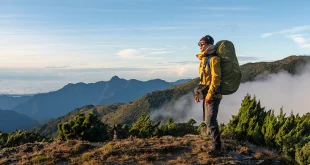When I first started hiking, I underestimated just how important water really was. It wasn’t until a long, sweaty summer trek left me dizzy and exhausted that I understood: staying hydrated while hiking isn’t something you can take lightly. Now, water is the first thing I think about when planning a hike, whether it’s a short stroll or a challenging climb. In this article, I’ll share my personal experiences and tips for making sure you stay hydrated and healthy every time you hit the trail.
Why Water Is Your Best Hiking Companion
It didn’t take me long to realize that no amount of gear, fancy boots, or trail snacks could replace the simple need for water. Hiking makes you sweat, even on cooler days, and every step you take drains a little more moisture from your body.
Without enough water, I quickly lose energy, get irritable, and start to feel sluggish. Worse, I’ve seen hiking partners experience serious dehydration symptoms like nausea and confusion. That’s why staying hydrated while hiking is my number one priority, no matter the season or trail difficulty.
How Much Water Should You Really Drink?
At first, I had no idea how much water I should be carrying. After a few trial-and-error hikes (and a few uncomfortable dehydration headaches), I learned that the general rule is about half a liter of water per hour of moderate activity.
Of course, this isn’t a one-size-fits-all situation. On hotter days, when I’m tackling steeper climbs or spending hours at high altitudes, I bring more. Sometimes I even freeze a bottle the night before so it slowly melts into cold water as I hike. Staying hydrated while hiking means preparing enough water for the conditions, not just guessing and hoping for the best.
Adjusting for the Environment
Whenever I’m hiking in desert areas or in intense sun, I double my water intake plan. Dry air pulls moisture from your body faster than you think. On cooler, shaded trails, I still stay vigilant because hiking with a heavy backpack burns through fluids even without visible sweat.
I've made it a habit to sip often rather than chug huge amounts at once. It keeps my body steadily fueled and prevents that bloated feeling I sometimes get from drinking too much too quickly.
Water Sources on the Trail: Be Prepared
Early on, I made the mistake of assuming I could always find a stream or spring along the way. That assumption nearly backfired when a "reliable" creekbed I planned to use was completely dry. After that, I always carry all the water I think I’ll need—or bring a way to purify whatever I find.
Today, I never leave for a hike without either a small water filter or purification tablets. Even the clearest mountain stream can hide bacteria or parasites that could ruin not just your hike, but your entire week. Staying hydrated while hiking doesn’t just mean drinking; it means drinking safely.
Spotting the Signs of Dehydration
Knowing the early symptoms of dehydration has helped me catch problems before they get serious. If I notice myself feeling a little more tired than usual, or if my head starts to ache, I immediately take a break and drink.
Other times, the signs are subtler. Dry mouth, reduced sweating, darker urine, and slight dizziness are all red flags I’ve learned to watch for. Staying hydrated while hiking means paying attention to these signals and responding quickly. The trail will still be there after a water break—but pushing through without drinking can cut your hike (and your health) short.
How Heat and Altitude Make It Worse
Hiking in the heat can drain you faster than you realize. High altitudes also dry out your body more quickly because the air is thinner and holds less moisture. I've experienced this firsthand on mountain hikes where I didn’t even feel sweaty, but still ended up dangerously dehydrated.
When tackling high elevations, I make sure to drink even if I’m not thirsty. It's one of those habits that feels strange at first but ends up saving your energy in the long run.
Smart Ways to Carry Water
Back when I carried only one water bottle in my backpack’s side pocket, I found myself constantly stopping to dig it out. It interrupted my rhythm and made me less likely to drink often.
Now, I prefer using a hydration bladder with a drinking tube. It fits snugly in my pack and lets me sip without stopping. This small change completely transformed my hiking experience. Staying hydrated while hiking became much easier once I made water accessible at all times.
Backup Supplies Are Essential
Besides the hydration bladder, I usually tuck in a small collapsible bottle as a backup. If I pass a safe water source, I can easily refill it. When I expect long hours between water stops, I sometimes stash an electrolyte tablet in my pocket too, just to help replace the salts my body loses when I sweat.
Having a backup plan is something I learned after getting caught once without enough water miles from help. It’s not just smart—it’s essential for hiking safely.
Foods That Help Hydration
While water is the star of the show, I’ve also learned that some foods can support hydration too. Fresh fruits like oranges, watermelon slices, or cucumber sticks are great to bring along. They’re packed with water and provide a refreshing boost when I start to feel worn down.
Salty snacks are also part of my hiking kit. Things like trail mix, salted nuts, or jerky help balance my electrolytes and encourage me to drink more consistently. Staying hydrated while hiking isn’t just about guzzling water—it’s about fueling your body smartly along the way.
Tips to Build a Hydration Routine
Over time, staying hydrated while hiking has become second nature for me, but it didn’t happen overnight. Here’s how I built a habit that stuck:
- Drink Before You Go: I always drink at least a full glass of water before I even lace up my boots. Starting well-hydrated gives me a head start.
- Small Sips Often: Instead of waiting until I feel parched, I take a few sips every 15 to 20 minutes.
- Monitor Your Body: I watch for early signs of dehydration and adjust my pace if I need to.
- Plan Ahead: Before every hike, I check the weather, terrain, and distance to decide how much water and what supplies I’ll need.
Building these small habits has made a huge difference in how strong and energized I feel on every hike.
Final Thoughts
Water may seem simple, but it’s the key to unlocking your best hiking adventures. Without enough of it, the trail feels longer, the sun feels hotter, and your body starts working against you. But with the right preparation and a steady focus on hydration, every hike becomes more enjoyable and a lot safer.
If there’s one piece of advice I could offer to every new hiker, it’s this: never underestimate the importance of staying hydrated while hiking. It’s the one thing that can truly make or break your experience on the trail.
 Best Hiking Gear Hike More, Worry Less
Best Hiking Gear Hike More, Worry Less

